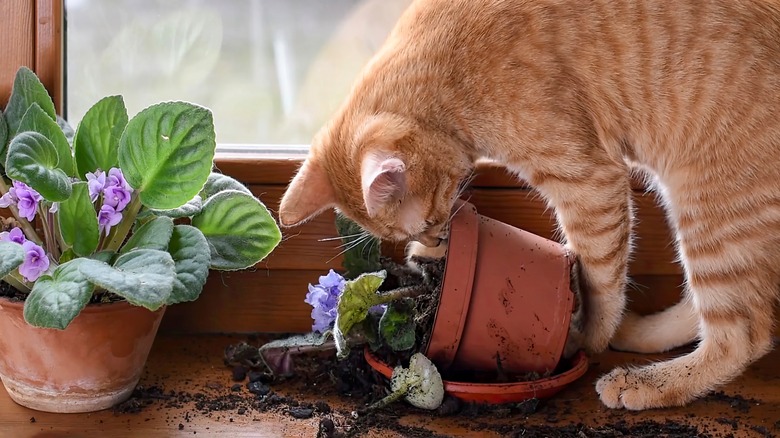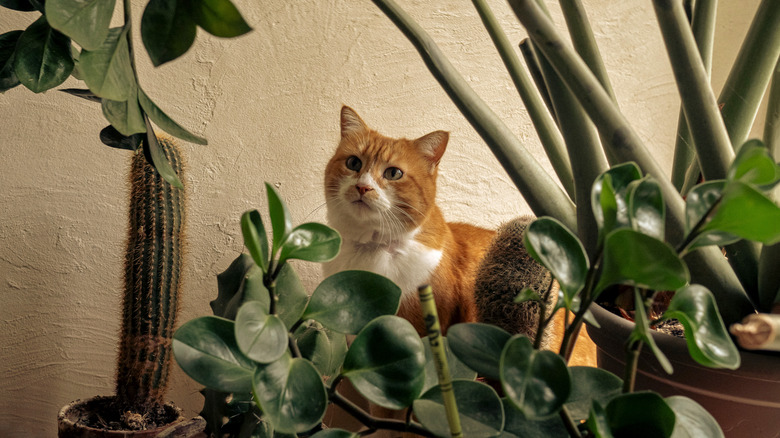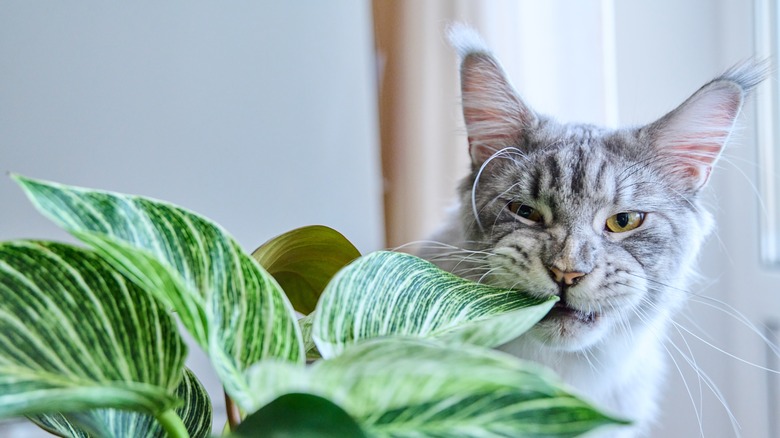Why Cat Owners Should Put Citrus Peels Around Their Houseplants
Unlike dogs and other omnivores, cats are what biologists call "obligate carnivores": they need to consume other animals to meet the nutritional requirements of their high-protein diets. But that often doesn't stop them from nibbling on houseplants, much to the chagrin of people who want to make room in their homes for both felines and flowers. The danger lies in more than the resulting mess of dirt on the windowsill.
Several common plants are toxic to cats, and some seem particularly drawn to eating any plant they can get their teeth on. Even small bites of these kinds of plants, however, can cause serious health problems — or prove fatal. Luckily, cats aren't as fond of the scent of citrus. Citrusy aromas overwhelm a cat's heightened sense of smell. So, if you're already eating lemons, oranges, or other similar fruits, veterinary nurse Helen Crofts suggests saving the peels and placing them around the base of a plant to repel a cat's interest, per Cats Protection.
Note that consuming the stems, leaves, seeds, or peels of citrus fruits in large quantities is also dangerous for your feline companion. "Citrus fruits contain the oils limonene, linalool and psoralens," veterinarian Dr. Sara Ochoa told The Dodo. "These are all toxic to cats." If you believe your feline is curious enough to ignore the dreadful scent that sends others scurrying away and try a bite anyway, consider another approach, like keeping only cat-safe plants in your home or making your plants inaccessible instead.
Common plants deemed unsafe for cats
Citrus peels can be used to protect a variety of plants from a prowling feline. However, it may be useful to identify and target toxic plants for treatment first to protect the cat itself from being poisoned. Ingesting common flowers such as daffodils, tulips, hyacinths, lilies, crocuses, chrysanthemums, and more causes symptoms like vomiting, excessive drooling, and stomach pain, among others. Other popular houseplants like shamrock plants, snake plants, jade plants, and desert roses also induce similar symptoms in cats and could benefit from a layer of citrus protection if they absolutely need to remain in an area accessible to your felines.
Keep an eye out, too, for holiday plants like American holly that, despite a spike in popularity only once a year, are just as dangerous. No list of toxic plants is likely to be 100% exhaustive, so it's important that you research the individual plants in your possession or that you plan to buy before (re)introducing them into a home occupied by one or more cats.
What to do if your cat ingests a toxic houseplant
There are several preventive measures you can take to protect a cat from poisonous plants and other hazards in the home, including using citrus peels as discussed. But sometimes things happen, and it's important to know how to respond in the event that your cat ingests something toxic. If you suspect that your feline has eaten a toxic houseplant, contact your veterinarian or a poison control center immediately. Quick consultation and treatment — even before definite signs of illness begin to appear — could be the difference between life and death.
If you're unable to get ahold of your cat's primary veterinarian at the time of the incident, the American Society for the Prevention of Animal Cruelty (ASPCA) operates its national Poison Control Center (APCC) hotline 24-hours-a-day, 365-days-a-year at 1-888-426-4435. The Pet Poison Hotline is also available 24/7 at 1-855-764-7661. Both offer their emergency services for a fee.


